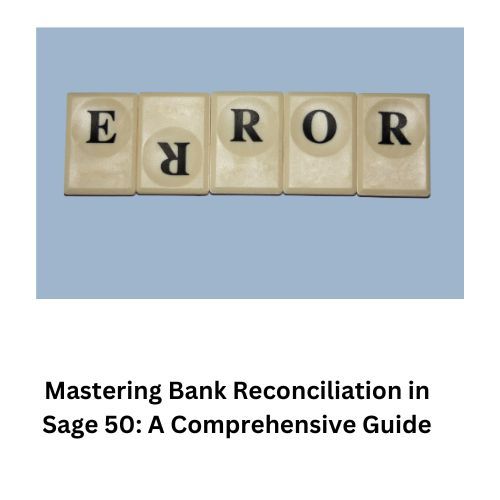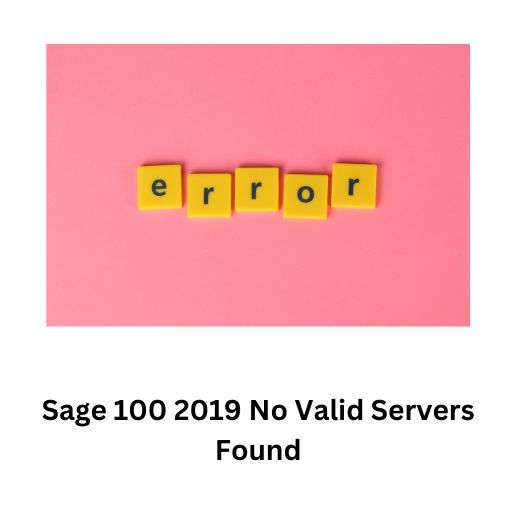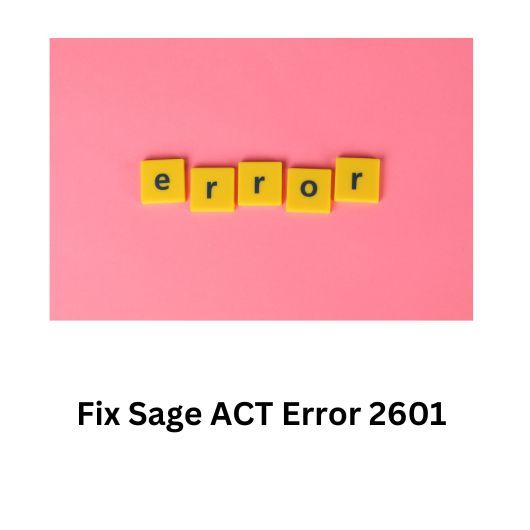#AccountingAdvice
Text
Troubleshooting Guide: Sage 50 Won't Open After the Update

Sage 50 is a robust accounting software trusted by many businesses for managing their finances efficiently. However, encountering issues like the software not opening after an update can be frustrating and disruptive to your workflow. In this blog post, we'll explore some common reasons why Sage 50 may fail to open after an update and provide troubleshooting steps to resolve the issue Sage 50 Wont Open after the Update.
1. Check System Requirements:
Before delving into troubleshooting, ensure that your system meets the minimum requirements for running Sage 50. Make sure your computer has sufficient disk space, RAM, and processor speed to support the software. Also, verify that you are using a compatible operating system version.
2. Restart Your Computer:
Sometimes, a simple restart can fix software glitches and errors. Close all applications, restart your computer, and then try opening Sage 50 again to see if the issue persists.
3. Verify Internet Connection:
Sage 50 may require an active internet connection, especially after an update, to validate the license or perform other tasks. Check your internet connection and ensure that it is stable. If you're using a firewall or antivirus software, make sure it's not blocking Sage 50 from accessing the internet.
4. Run as Administrator:
Try running Sage 50 as an administrator to see if it resolves the issue. Right-click on the Sage 50 shortcut or executable file and select "Run as administrator" from the context menu. This grants the software elevated privileges and may help bypass any permission-related issues.
5. Disable Compatibility Mode:
If Sage 50 is set to run in compatibility mode for an older version of Windows, it may encounter compatibility issues with the latest updates. Right-click on the Sage 50 shortcut, go to Properties, navigate to the Compatibility tab, and uncheck the box that says "Run this program in compatibility mode for." Click Apply and then OK to save the changes.
6. Repair Sage 50 Installation:
Corrupted installation files can prevent Sage 50 from opening properly. To repair the installation, navigate to the Control Panel, go to Programs > Programs and Features, find Sage 50 in the list of installed programs, right-click on it, and select Repair. Follow the on-screen instructions to complete the repair process.
7. Reinstall Sage 50:
If none of the above steps resolve the issue, consider reinstalling Sage 50. Uninstall the software from your computer, download the latest version from the official Sage website, and reinstall it. Be sure to backup your company data before uninstalling to prevent any data loss.
Conclusion:
Encountering issues with Sage 50 not opening after an update can be frustrating, but with the right troubleshooting steps, you can resolve the issue and get back to managing your finances seamlessly. By following the tips outlined in this guide, you can diagnose the problem and implement the necessary fixes to ensure Sage 50 runs smoothly on your system.
0 notes
Text
youtube
#TaxTips#FinanceAdvice#SmallBusinessCanada#EntrepreneurLife#MoneyManagement#BusinessOwners#FinancialEducation#TaxSeason2024#FinancialFreedom#TaxHelp#BudgetingTips#WealthBuilding#BusinessSuccess#AccountingAdvice#FinancialLiteracy#youtube#small youtuber#branding#marketing#ecommerce#entrepreneur#online business#Youtube
0 notes
Text
The Crucial Role of an Accounting Firm: How to Ensure You Choose the Best

Introduction
Accounting is the backbone of any successful business. It provides a clear and accurate picture of a company's financial health and helps in making informed decisions. While many businesses attempt to manage their finances in-house, the expertise of a professional accounting firm can be invaluable. Choosing the right accounting firm is a critical decision that can greatly impact your company's success. In this article, we will explore the crucial role of an accounting firm and provide tips on how to ensure you choose the best one for your needs.
The Role of an Accounting Firm
Financial Stability: An accounting firm helps you maintain financial stability by keeping your books in order. This includes managing income, expenses, taxes, and financial reporting. This stability is essential for decision-making, attracting investors, and ensuring compliance with tax regulations.
Tax Planning and Compliance: One of the primary roles of an accounting firm is to help you optimize your tax strategy. They can identify deductions, credits, and incentives that can save your business money while ensuring you comply with all tax laws and regulations.
Financial Analysis: Accounting firms can provide invaluable financial analysis and insights into your company's performance. This data can guide you in making strategic decisions, such as expanding your business, cutting costs, or adjusting pricing.
Risk Management: Managing financial risk is crucial for long-term success. Accounting firms help you identify potential financial risks and develop strategies to mitigate them. This is particularly important in an unpredictable business environment.
Efficiency and Productivity: Outsourcing accounting tasks to professionals allows you to focus on your core business activities, increasing efficiency and productivity. This can lead to improved profitability.
Tips for Choosing the Best Accounting Firm
Determine Your Needs: Before you start looking for an accounting firm, clearly define your needs. Are you looking for tax planning, financial analysis, or full-service accounting? Knowing your requirements will help you find a firm that specializes in the areas you need.
Credentials and Experience: Look for a firm with certified accountants who have experience in your industry. This expertise is crucial for understanding industry-specific nuances and challenges.
Reputation: Research the firm's reputation. Read client reviews and ask for referrals. A firm with a strong track record of client satisfaction is likely to provide quality service.
Communication: Effective communication is key to a successful partnership with an accounting firm. Ensure that they are responsive and able to explain complex financial concepts in a way that you can understand.
Technology and Tools: In the modern business landscape, technology plays a significant role in accounting. Ensure that the firm uses up-to-date accounting software and tools for accuracy and efficiency.
Fees and Budget: Discuss fees upfront and ensure they align with your budget. Remember that quality service often comes at a price, so balance cost considerations with the value the firm provides.
Personal Compatibility: Building a working relationship with your accounting firm is essential. Find a firm whose values and working style align with your own to create a smooth and productive partnership.
Conclusion
Choosing the right accounting firm is a crucial step in ensuring your business's financial health and success. An accounting firm's role in maintaining financial stability, tax planning, financial analysis, risk management, and improving efficiency cannot be overstated. By following the tips outlined in this article, you can make an informed decision and select the best accounting firm for your specific needs. This partnership will not only save you time and money but also provide the expertise necessary for your business's growth and long-term success.
#BusinessAccounting#FinancialSuccess#AccountingFirm#FinanceMatters#SmallBusinessTips#TaxPlanning#FinancialExperts#AccountingServices#BusinessGrowth#FindTheBest#MoneyMatters#FinancialStrategies#AccountingAdvice#BusinessPerformance#Budgeting#FinancialPlanning#ProfitMaximization#Entrepreneurship#MoneyManagement#ExpertConsultation#SMBFinance#CostSavings#FinancialWisdom#TaxSeason#AuditPreparation
0 notes
Text

Discover a realm of possibilities with Zoom Saas Accounting Software!
🚀📊 Our all-inclusive solution is tailor-made for CA, Tax Consultants, and Accountants, empowering you with unmatched efficiency and precision in financial management.
💼💡 Step into a new era of accounting excellence!
:
Here is the website: https://zoomsaasaccounting.com/
:
#accountinglife#accountingdepartment#accountingexpert#accountingsucks#startup#banking#accountants#businessowner#success#tax#smallbusinessowner#accountingmanagement#accountingadvice#accountingsolution#costaccounting#accountingprofessionals#accountingexperts#cpa#accountingassignmenthelp#bankingexams#accountingassignment#bankingandfinance#quickbooksonline#taxation#accounts#technology#womeninbusiness#quickbooksproadvisor#taxes
0 notes
Text
youtube
Guidelines on Claiming Business Losses as a Deduction
#TaxDeductions#BusinessLosses#TaxGuidelines#ClaimingLosses#TaxPlanning#SmallBusinessFinance#IRSRules#TaxFilingTips#BusinessExpenses#TaxSavings#AccountingAdvice#BusinessFinances#TaxSeason#TaxPreparation#TaxTips#TaxPlanningStrategies#Entrepreneurship#FinancialManagement#TaxWriteOffs#BusinessTax#TaxSavingsTips#Youtube
0 notes
Text

Professional Accountant Financial Advice by DNA
DNA can help you with your treatment and provide professional accounting financial advice! Call today to make an appointment or get more information visit the website.
0 notes
Photo

You can ask me! I'd love to help you smooth out your bookkeeping wrinkles and get your books back on track for the new year! DM me and we can set up a call where you pepper me with questions! . . [Image Description: White background with three large,light blue checkmarks bordered with mustard and pink. Navy blue text on top reads "Do you have a handful of bookkeeping questions?"] . . #bookkeepinghelp #bookkeepingadvice #accountinghelp #accountingadvice
0 notes
Photo

Answering ALL Your ACCOUNTING/CAREER QUESTIONS 🧐❓❔ | Long Q&A #2 http://ehelpdesk.tk/wp-content/uploads/2020/02/logo-header.png [ad_1] Hey guys, today I wanted to answ... #accountant #accountantjob #accounting #accountingadvice #accountingmajor #accountingmajoradvice #accountingmajorincollege #algorithmictrading #auditor #beinganaccountant #beinganaccountingmajor #big4accounting #businessmajorjobs #businessmajorsincollege #career #cfa #cpa #daytrading #excel #externalaudit #finance #financefundamentals #financialanalysis #financialmanagement #financialmodeling #financialtrading #forex #howtobesuccessfulinaccounting #investing #investmentbanking #optionstrading #personalfinance #publicaccountant #publicaccounting #qu0026a #stocktrading #technicalanalysis #tipsforeffectivestudyingincollege #whatitsliketobeacpa #whatitsliketoworkinpublicaccounting #work
0 notes
Text
Sage 50 Won’t open after the Update
If you're experiencing issues with Sage 50 not opening after a recent update, you're not alone. This problem can be frustrating, but fear not, as there are steps you can take to troubleshoot and resolve the issue. In this guide, we'll walk you through some common causes and solutions to Sage 50 Won't Open after the Update and get Sage 50 up and running smoothly again.
1. Check for Compatibility:
- Ensure that your version of Sage 50 is compatible with your operating system. Sometimes updates can introduce compatibility issues.
- Verify that your system meets the minimum requirements for running Sage 50.
2. Restart Your Computer:
- It may seem simple, but a restart can often resolve software glitches and conflicts.
- Close all other applications before restarting to ensure a clean boot.
3. Run as Administrator:
- Right-click on the Sage 50 shortcut or executable file and select "Run as administrator".
- This can help bypass any permission-related issues that might be preventing Sage 50 from opening.
4. Disable Antivirus/Firewall:
- Your antivirus or firewall software might be blocking Sage 50 from opening.
- Temporarily disable your antivirus or firewall and try opening Sage 50 again to see if the issue is resolved.
5. Check for Updates:
- Make sure you have the latest updates installed for Sage 50.
- Sometimes, new updates can address bugs and compatibility issues that may be causing Sage 50 not to open.
0 notes
Text
How to Convert Accounts Payable to Sage 100

In the realm of business finance management, efficiency is key. Any entrepreneur or business owner knows that managing accounts payable is a crucial aspect of maintaining financial health. This process involves tracking and managing the money a company owes to its suppliers, vendors, and creditors. However, as a business grows, the task of managing accounts payable can become increasingly complex and time-consuming. This is where reliable accounting software like Sage 100 comes into play (Convert Accounts Payable to Sage 100).
Sage 100 is a robust accounting solution that offers a comprehensive suite of features designed to streamline financial processes and improve overall efficiency. Whether you're a small business looking to upgrade your accounting software or a large enterprise seeking better ways to manage accounts payable, transitioning to Sage 100 can be a game-changer.
Here's a step-by-step guide on how to convert your accounts payable process to Sage 100
1. Evaluate Your Current Process: Before making any changes, it's essential to assess your existing accounts payable process. Identify pain points, inefficiencies, and areas for improvement. Consider factors such as manual data entry, duplicate payments, late fees, and lack of visibility into cash flow.
2. Choose the Right Version of Sage 100: Sage 100 offers various versions tailored to different business needs. Whether you're a small business or a large enterprise, there's a version of Sage 100 that fits your requirements. Evaluate the features offered in each version and choose the one that best aligns with your business goals and budget.
3. Data Migration and Setup: Once you've selected the appropriate version of Sage 100, it's time to migrate your accounts payable data. This involves transferring vendor information, outstanding invoices, payment history, and other relevant data into the Sage 100 system. Depending on the complexity of your existing data, you may need assistance from Sage consultants or IT professionals to ensure a smooth transition.
4. Customize Settings and Preferences: Sage 100 allows for extensive customization to suit your specific business needs. Set up default payment terms, vendor discounts, approval workflows, and other preferences to align with your existing accounts payable processes. This customization ensures that Sage 100 integrates seamlessly into your business operations.
5. Training and Onboarding: Proper training is essential to ensure that your team can effectively use Sage 100 to manage accounts payable. Provide comprehensive training sessions for employees involved in the accounts payable process, including accounting staff, procurement teams, and department heads. Additionally, consider offering ongoing support and resources to address any questions or challenges that may arise during the transition period.
6. Implement Best Practices: As you begin using Sage 100 for accounts payable management, incorporate best practices to optimize efficiency and accuracy. This includes regularly reconciling accounts, maintaining accurate vendor records, enforcing approval processes, and leveraging reporting tools to gain insights into cash flow and spending patterns.
7. Monitor and Adjust: After transitioning to Sage 100, continuously monitor your accounts payable process for any issues or areas that require improvement. Solicit feedback from users and stakeholders to identify pain points and make necessary adjustments. Sage 100 offers reporting and analytics capabilities that allow you to track key metrics and performance indicators, enabling you to make data-driven decisions to optimize your accounts payable process further.
In conclusion, converting accounts payable to Sage 100 can significantly streamline your business finances, improve efficiency, and reduce manual errors. By following the steps outlined above and leveraging the robust features of Sage 100, you can take control of your accounts payable process and set your business up for long-term success.
#convertaccountspayabletosage100#sage100#convertaccountspayable#accountspayable#accountingadvice#accountingsoftware
0 notes
Text
Sage 50 US Edition Permission Utility: A Comprehensive Guide

Sage 50 US Edition is a robust accounting software solution trusted by businesses of all sizes to manage their finances efficiently. However, as businesses grow, so do their needs for security and control over their financial data. This is where the Sage 50 US Edition Permission Utility comes into play. In this blog post, we'll explore what the Permission Utility is, why it's important, and how to effectively use it to enhance security and streamline operations within your organization.
Understanding Sage 50 US Edition Permission Utility
The Sage 50 US Edition Permission Utility is a feature designed to provide administrators with granular control over user access and permissions within the software. By defining specific permissions for each user or user role, organizations can ensure that employees only have access to the features and data necessary for their roles, thus minimizing the risk of unauthorized access or data breaches.
Key Features and Benefits
1. Granular Control: With the Permission Utility, administrators can define permissions at a granular level, specifying which features, modules, and data each user or user role can access within Sage 50 US Edition.
2. Enhanced Security: By restricting access to sensitive financial data and functions, the Permission Utility helps organizations strengthen their security posture and mitigate the risk of unauthorized access or fraudulent activities.
3. Compliance Compliance: Many industries have strict regulatory requirements regarding data privacy and security. The Permission Utility enables organizations to ensure compliance with these regulations by controlling access to sensitive financial information.
4. Improved Efficiency: By customizing user permissions based on job roles and responsibilities, organizations can streamline workflows and improve overall efficiency. Users only have access to the features and data relevant to their roles, reducing the likelihood of errors or misuse of the software.
How to Use the Sage 50 US Edition Permission Utility
1. Accessing the Permission Utility: To access the Permission Utility in Sage 50 US Edition, navigate to the "Maintain" menu and select "Users."
2. Defining User Roles: Before assigning permissions, it's important to define user roles within your organization. Consider the different job functions and responsibilities within your team and create user roles accordingly.
3. Assigning Permissions: Once user roles are defined, you can assign permissions to each role using the Permission Utility. Specify which features, modules, and data each role can access, and set appropriate restrictions as needed.
4. Testing and Review: After configuring permissions, it's essential to test the settings to ensure they align with your organization's requirements. Conduct periodic reviews to make any necessary adjustments based on changes in staffing or business needs.
Conclusion
The Sage 50 US Edition Permission Utility is a powerful tool for enhancing security, streamlining operations, and ensuring compliance within your organization. By leveraging the granular control, it provides over user access and permissions, businesses can effectively manage their financial data while minimizing risks associated with unauthorized access or misuse.
0 notes
Text
Upgrading to Sage 50 Cloud 2019.2

In the ever-evolving landscape of business management software, staying ahead of the curve is paramount. As businesses grow and adapt to changing needs, so too must their tools. For those utilizing Sage 50 Cloud, the upgrade to Sage 2019.2 (Sage 50 Cloud Upgrading to Sage 2019.2) marks a significant stride forward, offering a plethora of new features and enhancements designed to streamline operations, boost efficiency, and empower users like never before.
Seamless Integration & Enhanced Connectivity
One of the standout features of Sage 2019.2 is its improved integration capabilities and enhanced connectivity. In today's interconnected world, the ability to seamlessly sync data across various platforms is crucial. With this upgrade, users can expect smoother integration with third-party applications, allowing for more efficient data sharing and workflow automation. Whether it's syncing with CRM systems, e-commerce platforms, or payroll services, Sage 2019.2 ensures that your business operates seamlessly within your tech ecosystem.
Advanced Reporting & Analytics
Data-driven decision-making is at the heart of every successful business. Sage 2019.2 empowers users with advanced reporting and analytics tools that provide deeper insights into business performance. From customizable dashboards to real-time reporting capabilities, accessing key metrics and KPIs has never been easier. With the ability to generate comprehensive reports at the click of a button, businesses can gain a competitive edge by making informed decisions based on accurate data.
Enhanced Security & Compliance
In an age where cyber threats are becoming increasingly sophisticated, safeguarding sensitive data is paramount. Sage 2019.2 takes security to the next level with enhanced encryption protocols and multi-factor authentication options. By implementing robust security measures, businesses can mitigate the risk of data breaches and ensure compliance with industry regulations such as GDPR and HIPAA. With peace of mind knowing that their data is secure, users can focus on driving business growth without worrying about potential security threats.
Streamlined User Experience
Usability is key when it comes to software adoption, and Sage 2019.2 delivers an intuitive user experience that enhances productivity. From a redesigned user interface to simplified navigation, every aspect of the software has been optimized to streamline workflows and minimize friction. Whether you're a seasoned Sage user or new to the platform, the intuitive design of Sage 2019.2 makes it easy to hit the ground running and unlock the full potential of the software from day one.
Conclusion
In conclusion, the upgrade to Sage 50 Cloud 2019.2 represents a significant leap forward in business management software. With its seamless integration capabilities, advanced reporting tools, enhanced security features, and streamlined user experience, Sage 2019.2 empowers businesses to thrive in today's fast-paced digital landscape. By embracing the latest advancements in technology, businesses can unlock new levels of efficiency, productivity, and profitability. So why wait? Upgrade to Sage 2019.2 today and take your business to new heights.
#sage50cloudupgradetosage2019.2#sage50cloudupgrade#sage50cloud#sage2019.2#sage2019#accountingadvice#accountingsoftware
0 notes
Text
Mastering Bank Reconciliation in Sage 50: A Comprehensive Guide

Bank reconciliation is an essential task for any business, ensuring that financial records match the transactions recorded in your bank statements. For Sage 50 users, mastering bank reconciliation can streamline financial processes, enhance accuracy, and provide valuable insights into your company's financial health. In this guide, we'll delve into the intricacies of enabling bank reconciliation in Sage 50 and offer tips for maximizing its efficiency.
Understanding Bank Reconciliation in Sage 50
Bank reconciliation in Sage 50 involves comparing your internal financial records with your bank statements to ensure they align accurately. By reconciling your accounts regularly, you can identify discrepancies, track outstanding transactions, and detect errors or fraudulent activities promptly.
Enabling Bank Reconciliation in Sage 50
1. Accessing Bank Reconciliation Feature: To enable bank reconciliation in Sage 50, navigate to the Banking menu and select "Reconcile Bank Accounts."
2. Selecting Bank Account: Choose the bank account you wish to reconcile from the list of available accounts.
3. Entering Statement Date: Input the ending date of your bank statement. This date signifies the period up to which you're reconciling transactions.
4. Reviewing Transactions: Sage 50 will display a list of transactions recorded in your account. Compare these transactions with your bank statement, ensuring accuracy and completeness.
5. Marking Reconciled Transactions: As you verify transactions, mark them as reconciled within Sage 50 to indicate that they match your bank statement.
6. Handling Discrepancies: If you encounter discrepancies between your internal records and the bank statement, investigate and resolve them promptly. Common discrepancies may include bank fees, outstanding checks, or unrecorded transactions.
7. Completing Reconciliation: Once all transactions are reconciled, review the reconciliation summary provided by Sage 50. Ensure that the ending balance matches your bank statement's ending balance.
8. Finalizing Reconciliation: Confirm and finalize the reconciliation process in Sage 50. This action locks reconciled transactions and prevents inadvertent changes.
Tips for Efficient Bank Reconciliation in Sage 50
1. Regular Reconciliation: Schedule regular reconciliation sessions to ensure financial accuracy and identify discrepancies promptly.
2. Documenting Discrepancies: Keep detailed records of any identified discrepancies and resolutions to maintain a clear audit trail.
3. Utilizing Reconciliation Reports: Sage 50 offers various reconciliation reports, such as bank reconciliation reports and discrepancy reports. Utilize these reports to analyze trends, track outstanding items, and enhance financial oversight.
4. Monitoring Cash Flow: Bank reconciliation provides insights into your company's cash flow and financial performance. Leverage this information to make informed decisions and optimize cash management strategies.
5. Training and Education: Invest in training resources and education for your accounting team to ensure they understand the bank reconciliation process in Sage 50 thoroughly.
Conclusion
Bank reconciliation is a critical aspect of financial management for businesses of all sizes. In Sage 50, enabling and mastering bank reconciliation can streamline your accounting processes, enhance accuracy, and facilitate informed decision-making. By following the steps outlined in this guide and implementing best practices, you can optimize your bank reconciliation workflow and gain greater control over your company's finances.
#enablebankreconciliationinsage50#enablebankreconciliation#bankreconciliation#reconciliationinsage50#sage50#accountingadvice#accountingsoftware
0 notes
Text
Understanding Nominal Codes in Sage 50 Accounts: A Comprehensive Guide

Nominal codes play a pivotal role in Sage 50 Accounts, serving as the backbone for organizing and categorizing financial transactions within your accounting system. As a fundamental element of Sage 50, understanding nominal codes is essential for maintaining accurate records and generating insightful financial reports. In this guide, we delve into the intricacies of nominal codes (Nominal Code in Sage 50 Accounts), their significance, and how they function within the Sage 50 platform.
What are Nominal Codes?
Nominal codes, also known as account codes or general ledger codes, are numerical identifiers assigned to different categories of income, expenses, assets, and liabilities within an accounting system. These codes facilitate the systematic classification and tracking of financial transactions, enabling businesses to monitor their financial activities with precision and clarity.
In Sage 50 Accounts, nominal codes are structured hierarchically, with each code representing a specific nominal account or financial category. These categories typically include revenue, cost of sales, overhead expenses, assets, liabilities, and equity, among others. By assigning transactions to appropriate nominal codes, businesses can accurately record their financial performance and analyze expenditure patterns.
Importance of Nominal Codes in Sage 50 Accounts
1. Organization and Structure: Nominal codes provide a structured framework for organizing financial data within Sage 50. By categorizing transactions into distinct nominal accounts, businesses can maintain orderly records and streamline their accounting processes.
2. Accurate Reporting: Nominal codes form the basis for generating comprehensive financial reports in Sage 50 Accounts. Whether it's profit and loss statements, balance sheets, or cash flow analyses, nominal codes allow businesses to extract meaningful insights into their financial performance.
3. Tracking Expenses and Revenue: By associating transactions with specific nominal codes, businesses can track their expenses and revenue streams with precision. This level of granularity enables businesses to monitor expenditure trends, identify cost-saving opportunities, and assess the profitability of different operations.
4. Facilitates Budgeting and Forecasting: Nominal codes play a crucial role in budgeting and forecasting processes. By allocating budgeted amounts to different nominal accounts, businesses can set financial targets, monitor variances, and make informed decisions to achieve their strategic objectives.
Utilizing Nominal Codes in Sage 50 Accounts
1. Assigning Nominal Codes to Transactions: When recording transactions in Sage 50, users must assign the appropriate nominal code to each entry. This ensures that transactions are correctly categorized within the accounting system.
2. Creating Custom Nominal Codes: Sage 50 Accounts allows users to create custom nominal codes tailored to their specific accounting requirements. This flexibility enables businesses to adapt their chart of accounts to reflect the unique structure of their operations.
3. Reviewing and Reconciling Nominal Balances: Regularly reviewing nominal balances is essential for ensuring the accuracy and integrity of financial data in Sage 50. By reconciling nominal balances against supporting documentation, businesses can identify discrepancies and rectify errors promptly.
4. Generating Financial Reports: Sage 50 Accounts offers a range of pre-defined financial reports that leverage nominal codes to summarize financial performance. Users can customize these reports to focus on specific nominal accounts or time periods, providing valuable insights for decision-making.
Conclusion
Nominal codes form the cornerstone of effective financial management in Sage 50 Accounts. By leveraging these codes to categorize and track financial transactions, businesses can maintain accurate records, analyze their financial performance, and make informed decisions to drive success. Understanding the role and significance of nominal codes is essential for harnessing the full potential of Sage 50 and optimizing your accounting processes.
0 notes
Text
Sage 100 2019 No Valid Servers Found- Fix

Are you a Sage 100 user who recently encountered the dreaded "No Valid Servers Found" error in the latest version, Sage 100 2019? Don't fret! We've got you covered. In this blog post, we'll dive into the causes of this frustrating issue and provide you with a step-by-step guide to fix it. Whether you're an experienced user or new to Sage 100 or Sage 100 2019 No Valid Servers Found, we've got all the troubleshooting tips you need to get your system up and running smoothly again.
What is the "No Valid Servers Found" Error in Sage 100 2019?
If you're a user of Sage 100 2019, you might have come across the frustrating error message that says "No Valid Servers Found." But what does it actually mean? In simple terms, this error occurs when your system cannot detect any valid servers to connect with. It could happen due to various reasons, such as network issues or incorrect server configurations.
Possible Causes of the Error
There are several potential causes for the "No Valid Servers Found" error. It could be due to a temporary network interruption or firewall settings blocking communication between your system and the server. Another possible cause is an incorrect configuration of your server settings in Sage 100 2019.
Step-by-step guide to fixing the error
1. Check your network connection: The first step in resolving the "No Valid Servers Found" error is to ensure that your network connection is stable. Make sure you are connected to the internet and can access other websites or applications without any issues.
2. Restart Sage 100: Sometimes, a simple restart of the Sage 100 software can resolve this error. Close the program completely and reopen it to see if the error message disappears.
3. Verify server settings: Double-check that you have entered the correct server information in Sage 100. Go to File > Run Setup > Server Settings and confirm that everything is accurate, including the server name, port number, and login credentials.
4. Disable firewall or antivirus software: In some cases, security software might be blocking communication between Sage 100 and your server. Temporarily disable any firewall or antivirus programs on your computer and try accessing Sage 100 again.
5. Reinstall Sage 100: If none of these steps have resolved the issue, you may need to reinstall Sage 100 on your system. Uninstall it completely from Control Panel > Programs & Features, then download a fresh copy of the software from their official website and reinstall it following their instructions carefully.
Conclusion
Encountering the "Sage 100 2019 No Valid Servers Found" error can be frustrating, but with the right troubleshooting steps and preventive measures, you can quickly resolve the issue and ensure it doesn't happen again in the future. Remember to check for common causes such as network connectivity issues or server configuration problems.
#sage1002019novalidserversfound#sage1002019#sage100#novalidserversfound#accountingadvice#accountingsoftware
0 notes
Text
Fix Sage ACT Error 2601

Are you a user of Sage ACT software? Have you ever encountered the frustrating Error 2601? Well, fear not! In this blog post, we will dive into the world of Sage ACT and explore how to fix Error 2601. Whether you're a seasoned pro or just starting out with this powerful CRM tool, understanding and resolving this error is crucial for smooth operations. So, let's roll up our sleeves and get ready to troubleshoot like pros!
Main Causes of Sage ACT Error 2601
One of the most frustrating experiences for users of Sage ACT is encountering error messages. One such error that can disrupt your workflow is Error 2601. Understanding the main causes behind this error can help you troubleshoot and resolve it effectively.
The primary cause of Sage ACT Error 2601 is a corrupt or damaged database file. This could occur due to various reasons, such as improper shutdowns, system crashes, or even malware attacks. Additionally, if there are duplicate records within your database, it can lead to conflicts and trigger this error.
Another potential cause could be outdated software. If you have not updated your Sage ACT program to the latest version, it may encounter compatibility issues with your operating system or other applications installed on your computer.
In some cases, hardware problems like faulty RAM or hard drive errors can also contribute to Error 2601. These issues may result in data corruption and affect the functioning of your Sage ACT software.
Steps to Fix Sage ACT Error 2601
Step 1: Verify Database Integrity
To begin resolving Sage ACT Error 2601, the first step is to verify the integrity of your database. This can be done by going to the "Database Maintenance" section in the software and selecting "Check and Repair." This process will scan your database for any inconsistencies or errors that may be causing the issue.
Step 2: Check for Duplicate Records
Another common cause of Error 2601 in Sage ACT is duplicate records within your database. These duplicates can lead to conflicts and errors when trying to access or manipulate data. To check for duplicates, you can use the built-in deduplication feature in Sage ACT or manually search for potential duplicates based on criteria such as name, email address, or phone number.
Step 3: Update Sage ACT Software
Updating your Sage ACT software to the latest version can often help resolve various errors, including Error 2601. Newer versions usually come with bug fixes and improvements that address known issues. To update your software, simply go to the Help menu and select "Check for Updates." Follow the prompts to download and install any available updates.
By following these steps, you should be able to fix Sage ACT Error 2601 and regain full functionality of your CRM system. Remember to always back up your database before making any changes or updates in order to avoid data loss.
0 notes